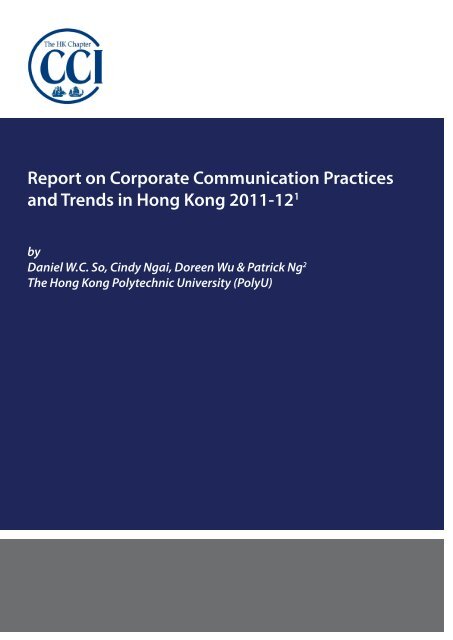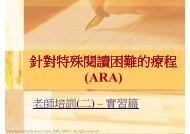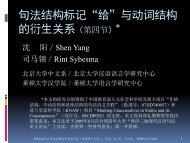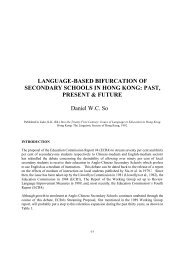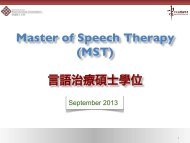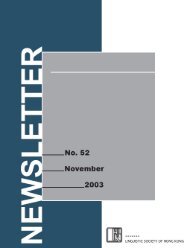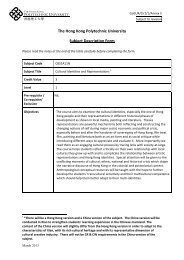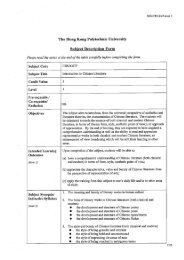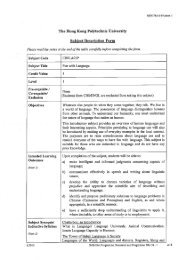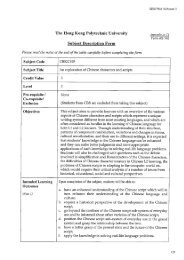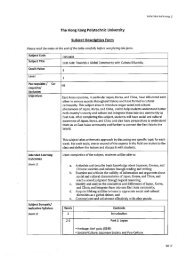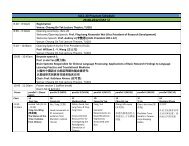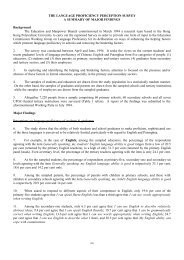Corporate Communication Practices and Trends in Hong Kong 2011 ...
Corporate Communication Practices and Trends in Hong Kong 2011 ...
Corporate Communication Practices and Trends in Hong Kong 2011 ...
Create successful ePaper yourself
Turn your PDF publications into a flip-book with our unique Google optimized e-Paper software.
Report on <strong>Corporate</strong> <strong>Communication</strong> <strong>Practices</strong><br />
<strong>and</strong> <strong>Trends</strong> <strong>in</strong> <strong>Hong</strong> <strong>Kong</strong> <strong>2011</strong>-12 1<br />
by<br />
Daniel W.C. So, C<strong>in</strong>dy Ngai, Doreen Wu & Patrick Ng 2<br />
The <strong>Hong</strong> <strong>Kong</strong> Polytechnic University (PolyU)
CONTENTS<br />
PREFACE<br />
Preface<br />
F<strong>in</strong>d<strong>in</strong>gs <strong>and</strong> Interpretation<br />
(Part A: multiple-choice items)<br />
F<strong>in</strong>d<strong>in</strong>gs <strong>and</strong> Interpretation<br />
(Part B: open-ended items)<br />
Conclusions <strong>and</strong> Discussion<br />
References<br />
End Notes<br />
Appendix<br />
p. 1<br />
p. 2 - 5<br />
p. 6 - 7<br />
p. 8<br />
p. 9<br />
p. 9<br />
p. 10 - 13<br />
In connection with benchmark studies on the same topic conducted about the<br />
Ch<strong>in</strong>ese ma<strong>in</strong>l<strong>and</strong> (Feng & Goodman, 2010), the European Union (Fr<strong>and</strong>sen, &<br />
Johansen, 2008), South Africa (de Wet et al., 2008) <strong>and</strong> the United States (e.g.<br />
Goodman, <strong>2011</strong>), this study, conducted under the auspices of the <strong>Hong</strong> <strong>Kong</strong><br />
Chapter of CCI (CCI-HKC), attempts to <strong>in</strong>itiate a similar longitud<strong>in</strong>al study <strong>in</strong> HK<br />
(footnote 1 refers) to <strong>in</strong>form respectively local <strong>and</strong> overseas practitioners of the<br />
local status <strong>and</strong> trends of CC. Together with the aforementioned studies, it is<br />
hoped that the f<strong>in</strong>d<strong>in</strong>gs of this study will help contribute to the construction of<br />
a global mosaic about CC.<br />
Specifically, this study attempts to<br />
1. Establish respectively a profile of the corporate respondents <strong>and</strong><br />
their CC department<br />
2. Identify the major clients <strong>and</strong> major roles <strong>and</strong> functions of their<br />
CC department<br />
3. Identify the CC functions that are usually contracted out to<br />
external vendors<br />
4. F<strong>in</strong>d out respectively the respondents’ major concerns <strong>and</strong><br />
5. Their preferred attributes of graduat<strong>in</strong>g students who wish to<br />
adopt CC as their career<br />
The study, which takes the comb<strong>in</strong>ed form of a questionnaire-survey <strong>and</strong> <strong>in</strong>terviews<br />
conducted on a selective basis, commenced <strong>in</strong> June <strong>2011</strong>. The target<br />
population is corporations of medium-size or above that are operat<strong>in</strong>g <strong>in</strong> HK.<br />
The design of the questionnaire (see Appendix 1) <strong>and</strong> its <strong>in</strong>strumentation were<br />
conducted between June <strong>and</strong> September. The sampl<strong>in</strong>g list comprises respectively<br />
30 of the 48 corporate constituents of the Hang Seng Index (HSI) <strong>and</strong> 55<br />
corporate contacts on CCI-HKC’s mail<strong>in</strong>g list. When the on-l<strong>in</strong>e version of the<br />
questionnaire was operational <strong>in</strong> September <strong>2011</strong>, these 85 sampled corporations<br />
were contacted via a comb<strong>in</strong>ation of emails, letters, phone-calls <strong>and</strong> personal<br />
approaches. By the end of March 2012, 55 of the sampled corporations<br />
responded to the survey either on-l<strong>in</strong>e or via the phone, or by mail. 51 of the<br />
corporate participants can be identified. The response rate is 64.7%.<br />
1
FINDINGS AND INTERPRETATION (PART A: MULTIPLE-CHOICE ITEMS)<br />
As shown <strong>in</strong> Table 1, the majority of the corporate participants are based <strong>in</strong> <strong>Hong</strong><br />
<strong>Kong</strong> (70.9%); 74.5% are medium-sized <strong>and</strong> large corporations by local-staff size <strong>and</strong><br />
by the local norms (Footnote 3 refers). By their global staff size, all of them may be<br />
regarded as large corporations; 29.1% are very large, mult<strong>in</strong>ational corporations.<br />
TABLE 1: The Profile of the <strong>Corporate</strong> Participants<br />
(A) Attributes % (N=55) 8<br />
HSI corporate constituents 23.6<br />
Non-HSI constituents 9 76.4<br />
Headquartered <strong>in</strong><br />
• HK: 70.9<br />
• The West (Europe + North America) 20<br />
• Others: 9.1<br />
(B) Number of Full-Time Personnel:<br />
<strong>Hong</strong> <strong>Kong</strong><br />
Globally (<strong>in</strong>clud<strong>in</strong>g HK)<br />
Under 100 25.5% Under 200 14.5%<br />
101-1000 32.7% 201-3000 18.2%<br />
1001-3000 16.4% 3001-5000 16.4%<br />
3001-5000 9.1% 5001-10000 12.7%<br />
5001+ 14.5% 10001+ 29.1%<br />
NA 1.8% NA 9.1%<br />
As shown <strong>in</strong> Table 2A, the survey f<strong>in</strong>d<strong>in</strong>gs show that the respondents are mostly female<br />
(87.3%), relatively young <strong>in</strong> age <strong>and</strong> have relatively high educational qualifications.<br />
For example, accord<strong>in</strong>g to census statistics, <strong>in</strong> the year 2000 among those who<br />
are born <strong>in</strong> HK, only 13.3% held a university degree. Whereas not only do close to 93%<br />
of the respondents have such a degree, another 49% have postgraduate qualifications.<br />
The f<strong>in</strong>d<strong>in</strong>gs related to departmental title (footnote 3 refers) <strong>and</strong> department-head<br />
title CC’s para-professional status <strong>in</strong> HK. For example, the title of the department<br />
head varies almost from corporate participant to participant. It calls for a world-wide<br />
comparative study about this phenomena <strong>and</strong> efforts for engender<strong>in</strong>g a measure of<br />
st<strong>and</strong>ardization <strong>in</strong> nam<strong>in</strong>g these <strong>and</strong> other related titles as an <strong>in</strong>dication of professionalism<br />
is the presence of a widely accepted nomenclature. However, it is encourag<strong>in</strong>g<br />
to note that, as <strong>in</strong>dicated <strong>in</strong> Table 2D, close to half of the respondents <strong>in</strong>dicates<br />
that the department head reports directly to the CEO. Apparently it reflects corporate<br />
senior management’s grow<strong>in</strong>g awareness of the strategic significance of CC functions<br />
nowadays.<br />
The f<strong>in</strong>d<strong>in</strong>gs related to budgets are tentative. As <strong>in</strong>dicated <strong>in</strong> Table 2C, probably because<br />
of its sensitive nature, only 60% of the respondents provide an estimate of the<br />
budget size of their CC department. Based on these returns, one may surmise that CC<br />
departments are relatively small vis-à-vis the size of the corporations concerned. For<br />
example, only 5.5% have a budget over HK$20M; the budget covers other expenses<br />
<strong>in</strong> addition to staff cost. Given the median salary of HR managers <strong>in</strong> HK is around<br />
HK$0.44M, <strong>and</strong> that of executive tra<strong>in</strong>ees around HK$0.14M, it is evident that the size<br />
of CC departments of the respondents is small. On the brighter side, over 30% of the<br />
respondents report an <strong>in</strong>crease <strong>in</strong> staff size <strong>in</strong> the previous f<strong>in</strong>ancial year.<br />
TABLE 2: The Profile of the Respondents & their CC Department<br />
(A) Personal & other attributes of the Respondents %<br />
Age: Below 40 70.9<br />
40-54 23.6<br />
55 or above 5.5<br />
Gender: Female 87.3<br />
Male 12.7<br />
Education: Post-Secondary 7.3<br />
Bachelor 43.6<br />
Master 47.3<br />
Doctoral 1.8<br />
(B) Title of the Head of their Department<br />
• Extensive divergence<br />
(C) Budget & Personnel Information of their Department<br />
Budget size Budget Decrease/Increase Personnel Changes<br />
Under 1m 23.6% - > 10% 1.8% ->one 3.6%<br />
1-5m 16.4% Same 34.5% - one 1.8%<br />
5-10m 10.9% + 5-10% 18.2% Same 36.4%<br />
10-20m 3.6% + > 10% 5.5% + one 9.1%<br />
Over 20m 5.5% NA 40.0% +>one 21.8%<br />
NA 40.0% - > 10% 1.8% NA 27.3%<br />
(D) The Head of Department reports to<br />
• The Chief Executive Officer 47.3%<br />
• The Chief F<strong>in</strong>ance Officer 3.6%<br />
• The Chief Operat<strong>in</strong>g Officer 9.1%<br />
• The Chief Information Officer 0%<br />
• None of the above 40%<br />
As for the major clients/stakeholders <strong>and</strong> responsibilities of the Department, the survey<br />
f<strong>in</strong>d<strong>in</strong>gs show that on the one h<strong>and</strong> it appears that there is a good measure of<br />
overlap between it <strong>and</strong> other departments such as customer service <strong>and</strong> market<strong>in</strong>g, on<br />
2 3
the other h<strong>and</strong> an identifiable cluster of major clients <strong>and</strong> functions is <strong>in</strong> evidence, viz.<br />
<strong>in</strong> terms of major clients, they are media practitioners, customers <strong>and</strong> those affected<br />
by company bus<strong>in</strong>esses <strong>and</strong>/or projects, the CEO, colleagues of the market<strong>in</strong>g department,<br />
<strong>in</strong>vestors, members of social activist groups, <strong>and</strong> government officers. In terms<br />
of major functions performed, they <strong>in</strong>clude rout<strong>in</strong>e PR functions, corporate br<strong>and</strong><strong>in</strong>g<br />
& image, crisis communication & management, customer service & communication,<br />
market<strong>in</strong>g, corporate social responsibility, advertis<strong>in</strong>g, goods & services br<strong>and</strong><strong>in</strong>g, <strong>and</strong><br />
corporate philanthropy.<br />
As for major bus<strong>in</strong>ess tasks performed, these <strong>in</strong>clude mount<strong>in</strong>g corporate events &<br />
exhibitions, organiz<strong>in</strong>g press conferences/enquiries/releases, manag<strong>in</strong>g the corporate<br />
website, produc<strong>in</strong>g the annual/quarterly report, speech writ<strong>in</strong>g, edit<strong>in</strong>g the corporate<br />
newsletter for staff <strong>and</strong> hold<strong>in</strong>g staff social events. From the f<strong>in</strong>d<strong>in</strong>gs about these three<br />
aspects of the Department’s responsibilities, one may surmise media <strong>and</strong> customer<br />
relations, rout<strong>in</strong>e PR functions & br<strong>and</strong><strong>in</strong>g, event & website management, as well as<br />
corporate written communication largely def<strong>in</strong>e the niche of CC <strong>in</strong> HK.<br />
TABLE 3: Major Clients, Functions & Role of the CC Department<br />
% (exclud<strong>in</strong>g options picked by
FINDINGS AND INTERPRETATION (PART B: OPEN-ENDED ITEMS) 11<br />
When asked what they see as the major corporate communication challenges for<br />
their corporation or <strong>in</strong>dustry <strong>in</strong> the com<strong>in</strong>g year, 39 respondents provide their <strong>in</strong>put<br />
<strong>and</strong> the follow<strong>in</strong>g three topics receive the highest number of returns: budgetary <strong>and</strong><br />
resource str<strong>in</strong>gency associated with the conditions of the global economy (n=13),<br />
corporate br<strong>and</strong><strong>in</strong>g (n=12) <strong>and</strong> (social) media relations (n=8).<br />
Although the survey was done three years after the f<strong>in</strong>ancial tsunami, <strong>and</strong> that s<strong>in</strong>ce<br />
2010 the GDP of <strong>Hong</strong> <strong>Kong</strong> has recovered from its fall <strong>in</strong> 2009 <strong>and</strong> grown at 6.8%<br />
<strong>in</strong> 2010 <strong>and</strong> 7.2% <strong>in</strong> the first quarter of <strong>2011</strong>, concerns about the local <strong>and</strong> global<br />
economies, <strong>and</strong> the associated constra<strong>in</strong>ts imposed by budgetary str<strong>in</strong>gency are registered<br />
by the largest number of respondents. Six of these 13 respondents particularly<br />
mention the challenge posed by the volatile, weaken<strong>in</strong>g economic environment<br />
<strong>in</strong> Europe, <strong>and</strong> about how it might affect the economies of Asia <strong>in</strong> general, <strong>and</strong> HK<br />
<strong>in</strong> particular. Four of these 13 respondents also refer to grow<strong>in</strong>g competition <strong>in</strong> the<br />
bus<strong>in</strong>ess environment of <strong>Hong</strong> <strong>Kong</strong> as one of their challenges.<br />
It appears the f<strong>in</strong>ancial tsunami of 2008 <strong>and</strong> the grow<strong>in</strong>g competition <strong>in</strong> the Ch<strong>in</strong>ese<br />
Ma<strong>in</strong>l<strong>and</strong> market have accentuated the strategic significance of br<strong>and</strong><strong>in</strong>g as references<br />
to either or both of these two topics are <strong>in</strong> evidence <strong>in</strong> the <strong>in</strong>puts of those12<br />
respondents who identify br<strong>and</strong><strong>in</strong>g as a major challenge. In the case of the f<strong>in</strong>ancial<br />
tsunami, there are direct <strong>and</strong> <strong>in</strong>direct references to a need for the restoration of corporate<br />
reputation, <strong>and</strong>/or customer confidence. In case of the Ch<strong>in</strong>ese Ma<strong>in</strong>l<strong>and</strong> market,<br />
there are direct <strong>and</strong> <strong>in</strong>direct references to a need for development of an identity<br />
for the corporation <strong>and</strong> its products &/or services.<br />
The speedy pace of the development of social media <strong>and</strong> its management is found<br />
<strong>in</strong> the <strong>in</strong>put of eight or the third largest number of respondents for this item. Among<br />
their <strong>in</strong>puts, references are made particularly to the real-time nature of web communications<br />
<strong>and</strong> the immense extent of their outreach, especially among young people,<br />
<strong>and</strong> the need to formulate a corporate response to “web <strong>in</strong>cidents” at very short notice.<br />
It appears social-media monitor<strong>in</strong>g <strong>and</strong> management are perceived as a present<br />
<strong>and</strong> clear challenge; at the same time the social media <strong>and</strong> its associated social network<br />
are also perceived by several respondents as potentially a very powerful tool for<br />
CC, e.g. the provision of web-based social network<strong>in</strong>g services, if effective strategies<br />
could be developed by the <strong>in</strong>dustry to exploit the opportunities presented by their<br />
development.<br />
The <strong>in</strong>put of three respondents identify crisis management <strong>and</strong>/or social-activism<br />
management as a major challenge of the <strong>in</strong>dustry. Whereas the follow<strong>in</strong>g are perceived<br />
to be an <strong>in</strong>dustry challenge by at least one respondent:<br />
• To w<strong>in</strong> greater support of the senior corporate management <strong>and</strong> to change<br />
its m<strong>in</strong>dset about CC by demonstrat<strong>in</strong>g to them the strategic value of CC<br />
• Plugg<strong>in</strong>g the leakage of classified <strong>in</strong>formation vis-à-vis corporate<br />
transparency<br />
• <strong>Corporate</strong> restructur<strong>in</strong>g at the expense of CC<br />
• Increas<strong>in</strong>g dem<strong>and</strong> for social responsible projects<br />
• Hir<strong>in</strong>g <strong>and</strong> reta<strong>in</strong><strong>in</strong>g talented members of staff<br />
• Political-regime change<br />
• Political lobby<strong>in</strong>g<br />
• Budget-deficit avoidance vis-à-vis meet<strong>in</strong>g the different <strong>and</strong> compet<strong>in</strong>g<br />
<strong>in</strong>terests of different stakeholders<br />
When asked to identify one to three important traits for CC practitioners, 42 respondents<br />
provide their <strong>in</strong>put. Predictably good communication skills st<strong>and</strong> out <strong>in</strong> terms of<br />
the number of returns received (n=40). Trail<strong>in</strong>g beh<strong>in</strong>d are emotional maturity (n=15),<br />
<strong>in</strong>tellectual skills (n=10), socio-political awareness (n=8). Another 14 traits <strong>in</strong>clud<strong>in</strong>g<br />
IT & Media skills that lie outside the aforementioned categories receive three or less<br />
returns.<br />
When asked to comment on the quality of local graduates with reference to the previous<br />
question, 38 respondents provide their <strong>in</strong>put. Around 48 comments are made. A<br />
few comments are relatively vacuous <strong>and</strong> non-specific. Positive comments are few:<br />
three compliment the communication skills of female graduates; another three the<br />
graduates’ <strong>in</strong>tellectual skills. Interest<strong>in</strong>gly, only one comment compliments the graduates’<br />
IT & Media skills. Whereas about 36 comments are rather critical: 15 are about<br />
the graduates’ lack of communication skills, particularly Ch<strong>in</strong>ese <strong>and</strong> English written<br />
skills (n=9); 11 are about the graduates’ lack of emotional maturity; six are about the<br />
graduates’ lack of ground<strong>in</strong>g for their professional career. Only two are respectively<br />
about the graduates’ lack of <strong>in</strong>tellectual skills <strong>and</strong> socio-political awareness.<br />
When asked what recommendations they wish to give to the local universities with<br />
reference to the previous two questions, 36 respondents respond; about 64 suggestions<br />
are registered. Underst<strong>and</strong>ably, most suggestions relate to the need for<br />
enhanced tra<strong>in</strong><strong>in</strong>g of communication skills <strong>and</strong> provid<strong>in</strong>g the graduat<strong>in</strong>g students<br />
ground<strong>in</strong>g for the profession: specifically 22 suggestions are about the former, <strong>and</strong><br />
21 are about the latter. In case of the latter, 11 of the 21 suggestions are about the significance<br />
<strong>and</strong> value of mentorship programmes, practicum <strong>and</strong> <strong>in</strong>ternship. Another<br />
three highlight the significance <strong>and</strong> value of <strong>in</strong>volv<strong>in</strong>g practitioners <strong>in</strong> the educational<br />
processes. The rest of the suggestions relate to emotional-maturity development<br />
(n=8), Intellectual-skill development (n=4), curricular design & assessment (n=4) <strong>and</strong><br />
development of socio-political awareness (n=2).<br />
6 7
CONCLUSIONS AND DISCUSSION<br />
REFERENCES<br />
The present study, <strong>in</strong> spite of its limited scale, has yield useful <strong>in</strong>formation concern<strong>in</strong>g<br />
the isses that it sets out to <strong>in</strong>form. Its f<strong>in</strong>d<strong>in</strong>gs confirm that CC practitioners <strong>in</strong> HK are<br />
mostly well educated women. The department with which they affiliate is relatively<br />
small <strong>in</strong> both size <strong>and</strong> budget. There are no clear established titles for the department<br />
<strong>and</strong> its head, albeit close to half of the respondents <strong>in</strong>dicate that the department<br />
head reports directly to the CEO.<br />
Despite its para-professional status, the f<strong>in</strong>d<strong>in</strong>gs <strong>in</strong>dicate that the clusters of major<br />
clients served <strong>and</strong> functions performed by CC departments <strong>in</strong> HK are readily identifiable.<br />
Their major clients are media practitioners, customers <strong>and</strong> those affected by<br />
company bus<strong>in</strong>esses <strong>and</strong>/or projects, the CEO, colleagues of the market<strong>in</strong>g department,<br />
<strong>in</strong>vestors, members of social activist groups, <strong>and</strong> government officers. Their<br />
major functions are media <strong>and</strong> customer relations, rout<strong>in</strong>e PR functions, br<strong>and</strong><strong>in</strong>g,<br />
event & website management, as well as corporate written communication. These<br />
functions are also the usual ones that many of the corporate participants solicit the<br />
service of external agents <strong>and</strong>/or vendors.<br />
Our respondents also <strong>in</strong>dicate their personal <strong>and</strong>/or the corporation’s major concerns<br />
which are ma<strong>in</strong>ly related to the global economy, the dem<strong>and</strong> for corporate br<strong>and</strong><strong>in</strong>g<br />
<strong>and</strong> (social) media relations. They further op<strong>in</strong>e that competent CC practitioners<br />
should have good communication skills, emotional maturity, <strong>in</strong>tellectual skills, <strong>and</strong><br />
socio-political awareness. This f<strong>in</strong>d<strong>in</strong>g further affirms that CC is essentially a peopleoriented<br />
<strong>in</strong>dustry. In this connection, the respondents also<br />
<strong>in</strong>dicate their concerns that most graduat<strong>in</strong>g students have neither the necessary<br />
traits nor the necessary ground<strong>in</strong>g for their profession; many of them readily provide<br />
<strong>in</strong>put to the survey concern<strong>in</strong>g what the local universities could do for the profession<br />
<strong>in</strong> terms of enhanc<strong>in</strong>g the tra<strong>in</strong><strong>in</strong>g of communication skills, provid<strong>in</strong>g ground<strong>in</strong>g<br />
for the profession especially via mentorship programmes, practicum, <strong>and</strong> <strong>in</strong>volv<strong>in</strong>g<br />
practitioners <strong>in</strong> the educational processes.<br />
Limitations of the Study<br />
Accord<strong>in</strong>g to the HK Vocational Tra<strong>in</strong><strong>in</strong>g Council, there are over 22,000 people employed<br />
<strong>in</strong> the advertis<strong>in</strong>g <strong>and</strong> CC <strong>in</strong>dustry <strong>in</strong> 2010. The survey sample of this study<br />
is therefore hardly representative of the CC population of HK. Also, the corporate<br />
participants are mostly large corporations. Therefore the f<strong>in</strong>d<strong>in</strong>gs might have a degree<br />
of representation of CC departments of large, multi-national corporations only.<br />
The <strong>in</strong>terpretation of the f<strong>in</strong>d<strong>in</strong>gs must take these constra<strong>in</strong>ts <strong>in</strong>to account accord<strong>in</strong>gly.<br />
In the next survey to be commenced <strong>in</strong> October of 2012, because of logistic<br />
<strong>and</strong> resource limitations, <strong>in</strong> the next survey, large corporations will rema<strong>in</strong> our target<br />
population. Our plan is to first improve our sample’s representativeness of the large<br />
corporations. If feasible, we will exp<strong>and</strong> our coverage of medium-sized corporations.<br />
Feng, Jieyun & Michael B. Goodman. “<strong>Corporate</strong> <strong>Communication</strong> <strong>Practices</strong> <strong>and</strong> <strong>Trends</strong>: A Ch<strong>in</strong>a Study<br />
2010.” Proceed<strong>in</strong>gs of the International Conference on <strong>Corporate</strong> <strong>Communication</strong>, June 7-10, pp. 169 – 190<br />
de Wet, Gideon, Ilse Niemann-Struweg & Corne Me<strong>in</strong>tjes. “<strong>Corporate</strong> <strong>Communication</strong> <strong>Practices</strong> <strong>and</strong><br />
<strong>Trends</strong>: South Africa Benchmark Study 2007/8.” Paper presented at the International Conference on <strong>Corporate</strong><br />
<strong>Communication</strong>, June 6 – 9, 2008, Wroxton, Engl<strong>and</strong><br />
Goodman, Michael B. “CCI <strong>Corporate</strong> <strong>Communication</strong> <strong>Practices</strong> <strong>and</strong> <strong>Trends</strong>: US Study <strong>2011</strong>.” Proceed<strong>in</strong>gs<br />
of the International Conference on <strong>Corporate</strong> <strong>Communication</strong>, June 7-10, pp. 105 – 107<br />
Fr<strong>and</strong>sen, F<strong>in</strong>n & W<strong>in</strong>ni Johansen. ”<strong>Corporate</strong> <strong>Communication</strong> <strong>Practices</strong> <strong>and</strong> <strong>Trends</strong>: A European Union<br />
Benchmark Study 2008.” http://www.corporatecomm.org/pdf/EUPrelim<strong>in</strong>ary13_3_2008%20f<strong>in</strong>al.ppt.<br />
END NOTES<br />
1. This study, to be replicated <strong>in</strong> 2013 <strong>and</strong> 2014, was made possible by fund<strong>in</strong>gs provided by the Department of Ch<strong>in</strong>ese<br />
& Bil<strong>in</strong>gual Studies (CBS), PolyU.<br />
2. The <strong>in</strong>vestigators wish to acknowledge hereby the valuable assistance provided by Mr. David Hall (former<br />
Visit<strong>in</strong>g Fellow at CBS), <strong>and</strong> their project associates: Cherma<strong>in</strong>e Yam, Boris Lui <strong>and</strong> Tony Wei.<br />
3. The survey f<strong>in</strong>d<strong>in</strong>gs <strong>in</strong>dicate that the unit be<strong>in</strong>g studied carries a variety of titles. For our convenience, we use the label<br />
‘CC department’ to cover them all <strong>in</strong> this report.<br />
4. By HK norms (e.g. accord<strong>in</strong>g to the benchmark provided by the Support & Consultation Centre for SMEs of the Trade &<br />
Industrial Department), medium-sized corporations are those hav<strong>in</strong>g 100 or more employees on their full-time payroll.<br />
5. As a replication of the CCI studies, the design of the questionnaire of the HK study is done with close reference to that<br />
used <strong>in</strong> the US study of <strong>2011</strong>. However, <strong>in</strong> order to take <strong>in</strong>to account of the HK situation, <strong>and</strong> the fact that it is the HKC’s first<br />
study, some adaptations have been made. For example, the number of items is reduced from 27 to 24, with 19 of these<br />
items overlapp<strong>in</strong>g <strong>in</strong> vary<strong>in</strong>g degrees with their counterparts <strong>in</strong> the US study. The rema<strong>in</strong><strong>in</strong>g five items are “new” <strong>and</strong> are<br />
<strong>in</strong>cluded for a CC-related academic program at our university.<br />
6. The Hang Seng Index, accord<strong>in</strong>g to Wikipedia, is “a freefloat-adjusted market capitalization-weighted stock market<br />
<strong>in</strong>dex <strong>in</strong> <strong>Hong</strong> <strong>Kong</strong>. It is used to record <strong>and</strong> monitor daily changes of the largest companies of the <strong>Hong</strong> <strong>Kong</strong> stock market<br />
<strong>and</strong> is the ma<strong>in</strong> <strong>in</strong>dicator of the overall market performance <strong>in</strong> <strong>Hong</strong> <strong>Kong</strong>. These 48 constituent companies represent<br />
about 60% of capitalization of the <strong>Hong</strong> <strong>Kong</strong> Stock Exchange.”<br />
7. Because an “agreement of identity disclosure” was not <strong>in</strong>cluded <strong>in</strong> the survey, we are unable to provide a list of the<br />
corporate participants here. This agreement will be <strong>in</strong>cluded <strong>in</strong> the next survey.<br />
8. The percentages are based on an N size of 55 unless stated otherwise.<br />
9. This figure <strong>in</strong>cludes the four corporate participants that responded on-l<strong>in</strong>e <strong>and</strong> did not provide identity <strong>in</strong>formation;<br />
there is a chance there are HSI corporate constituents among these four participants.<br />
10. By respondent is meant the person who fills out the questionnaire. Most of them provide us with contact <strong>in</strong>formation<br />
for follow-up as well.<br />
11. The number of <strong>in</strong>puts to these four items varies from 42 to 36.<br />
12. All <strong>in</strong>puts related to language (spoken &/or written) skills, story-tell<strong>in</strong>g skills, <strong>in</strong>terpersonal skills, persuasive skills <strong>and</strong><br />
personal-groom<strong>in</strong>g skills are grouped under this trait.<br />
13. All <strong>in</strong>puts related to characteristics such as a pleasant &/or cheerful &/or sociable &/or outgo<strong>in</strong>g disposition, openm<strong>in</strong>dedness,<br />
forward-look<strong>in</strong>g, will<strong>in</strong>g to listen, will<strong>in</strong>g to learn <strong>and</strong> good time-management are grouped under this trait.<br />
14. All <strong>in</strong>puts related to characteristics such as detail-m<strong>in</strong>ded, strategic-th<strong>in</strong>k<strong>in</strong>g skills, flexible cognitive skills, adaptable<br />
to changes <strong>and</strong> new challenges, creativity <strong>and</strong> good IQ are grouped under this trait.<br />
15. All <strong>in</strong>puts related to characteristics such as sensitive/alert news <strong>and</strong> socio-economic change <strong>and</strong> development are<br />
grouped under this trait.<br />
16. Typical examples <strong>in</strong>clude pretty/quite good, reasonably well…<br />
8 9
APPENDIX<br />
<strong>Corporate</strong> <strong>Communication</strong> International<br />
(The <strong>Hong</strong> <strong>Kong</strong> Chapter)<br />
<strong>Corporate</strong> <strong>Communication</strong> (CC) <strong>Practices</strong> & <strong>Trends</strong> Study <strong>2011</strong><br />
The <strong>Hong</strong> <strong>Kong</strong> Polytechnic University<br />
Please provide the follow<strong>in</strong>g <strong>in</strong>formation about your company (Parts A & B), <strong>and</strong> yourself (Part C).<br />
Part A<br />
Please click the box next to the appropriate choice(s). Please click all that apply.<br />
1. Your company is headquartered <strong>in</strong>:<br />
o <strong>Hong</strong> <strong>Kong</strong><br />
o Ch<strong>in</strong>ese Ma<strong>in</strong>l<strong>and</strong><br />
o Japan<br />
o Taiwan<br />
o Asia (other polities)<br />
o Europe<br />
o North America<br />
o None of the Above<br />
2. Your company’s ma<strong>in</strong> bus<strong>in</strong>ess area(s) is/are:<br />
o F<strong>in</strong>ance<br />
o Hospitality & Tourism (Includ<strong>in</strong>g Cater<strong>in</strong>g)<br />
o Manufactur<strong>in</strong>g<br />
o Public Utilities<br />
o Real Estate<br />
o Retail<br />
o Trad<strong>in</strong>g<br />
o Others<br />
o Not Applicable<br />
3. The number of full-time personnel employed by your company <strong>in</strong> <strong>Hong</strong> <strong>Kong</strong> is:<br />
o Under 100<br />
o 101-1,000<br />
o 1,001-3,000<br />
o 3,001-5,000<br />
o 5,001 & above<br />
o Not Applicable<br />
4. The Number of full-time personnel employed by your company globally (<strong>in</strong>clud<strong>in</strong>g <strong>Hong</strong> <strong>Kong</strong>)<br />
is:<br />
o Under 200<br />
o 201-3,000<br />
o 3,001-5,000<br />
o 5,001-10,000<br />
o 10,001 & above<br />
o Not Applicable<br />
5. Identify <strong>in</strong> the follow<strong>in</strong>g the group(s) of people to whom your CC personnel mostly provide service:<br />
o Customers<br />
o Colleagues <strong>in</strong> the Market<strong>in</strong>g Department<br />
o Directors of the Board<br />
o Government Officers<br />
o Investors<br />
o Journalists <strong>and</strong>/or News Reporters<br />
o People Affected by Bus<strong>in</strong>esses/Projects of your Company<br />
o Social Activists<br />
o The CEO<br />
o Not Applicable<br />
6. Identify among the follow<strong>in</strong>g bus<strong>in</strong>ess functions those that your CC personnel are responsible<br />
for:<br />
o <strong>Corporate</strong> Br<strong>and</strong><strong>in</strong>g & Image<br />
o <strong>Corporate</strong> Philanthropy<br />
o <strong>Corporate</strong> Social Responsibility<br />
o Crisis <strong>Communication</strong> & Management<br />
o Influence Public Op<strong>in</strong>ion for Company’s Policies<br />
o Government Relations<br />
o Investor Relations<br />
o Lobby<strong>in</strong>g<br />
o Press Relations<br />
o None of the Above<br />
7. Identify <strong>in</strong> the follow<strong>in</strong>g bus<strong>in</strong>ess functions those that your CC personnel are also responsible for:<br />
o Advertis<strong>in</strong>g<br />
o Customer Service & <strong>Communication</strong><br />
o Goods & Services Br<strong>and</strong><strong>in</strong>g<br />
o Market<strong>in</strong>g<br />
o Staff Development<br />
o None of the Above<br />
8. Identify <strong>in</strong> the follow<strong>in</strong>g bus<strong>in</strong>ess tasks those that your CC personnel are <strong>in</strong>volved by a significant<br />
measure:<br />
o Annual &/or Quarterly Report Writ<strong>in</strong>g<br />
o <strong>Corporate</strong> Events &/or Exhibitions<br />
o <strong>Corporate</strong> Newsletter for Staff<br />
o Manag<strong>in</strong>g the <strong>Corporate</strong> Web-page of your Company<br />
o Press Conferences &/or Enquiries &/or Releases<br />
o Speech Writ<strong>in</strong>g<br />
o Staff Social Events (e.g. the Annual D<strong>in</strong>ner Party)<br />
o None of the Above<br />
9. Identify <strong>in</strong> the follow<strong>in</strong>g bus<strong>in</strong>ess functions those that you use agencies or vendors (<strong>in</strong> a substantial<br />
way) to accomplish:<br />
o Advertis<strong>in</strong>g<br />
o <strong>Corporate</strong> Br<strong>and</strong><strong>in</strong>g & Image<br />
o <strong>Corporate</strong> Philanthropy<br />
o <strong>Corporate</strong> Social Responsibility<br />
o Crisis <strong>Communication</strong> & Management<br />
10 11
o<br />
o<br />
o<br />
o<br />
o<br />
o<br />
o<br />
o<br />
o<br />
o<br />
Customer Service & <strong>Communication</strong><br />
Goods & Services Br<strong>and</strong><strong>in</strong>g<br />
Government Relations<br />
Influence Public Op<strong>in</strong>ion for Company’s Policies<br />
Investor Relations<br />
Lobby<strong>in</strong>g<br />
Market<strong>in</strong>g<br />
Press Relations<br />
Staff Development<br />
None of the Above<br />
15. Compared to previous fiscal year, the budget for CC at your company this fiscal year has<br />
o <strong>in</strong>creased by over 10%<br />
o <strong>in</strong>creased by 5% - 10%<br />
o no significant changes<br />
o decreased by 5% - 10%<br />
o decreased by over 10%<br />
o Not Applicable<br />
Part B<br />
Please give your views on the follow<strong>in</strong>g questions.<br />
10. Identify <strong>in</strong> the follow<strong>in</strong>g bus<strong>in</strong>ess tasks those that you use agencies or vendors (<strong>in</strong> a substantial<br />
way) to accomplish:<br />
o Annual &/or Quarterly Report<br />
o <strong>Corporate</strong> Events &/or Exhibitions<br />
o <strong>Corporate</strong> Newsletter for Staff<br />
o Manag<strong>in</strong>g the <strong>Corporate</strong> Web-page of your Company<br />
o Press Conferences &/or Enquiries &/or Releases<br />
o Speech Writ<strong>in</strong>g<br />
o Staff Social Events (e.g. the Annual D<strong>in</strong>ner Party)<br />
o None of the Above<br />
11. In your company, the top person responsible for corporate communication has the follow<strong>in</strong>g<br />
title:<br />
12. In your company, the top person responsible for CC functions reports to:<br />
o The Chief Executive Officer<br />
o The Chief F<strong>in</strong>ance Officer<br />
o The Chief Operat<strong>in</strong>g Officer<br />
o The Chief Information Officer<br />
o Others<br />
13. In your company, the budget for CC functions <strong>and</strong> activities (exclud<strong>in</strong>g staff & fixed overhead<br />
office cost) is approximately (HKD):<br />
o Under $1,000,000 (1m)<br />
o $1,000,001-5,000,000(5m)<br />
o $5,000,001-10,000,000(10m)<br />
o $10,000,001-20,000,000 (20m)<br />
o Over $20,000,000 (20m)<br />
o Not Applicable<br />
14. Compared to previous fiscal year, the number of CC personnel at your company this fiscal year<br />
has<br />
o <strong>in</strong>creased by more than 1 person<br />
o <strong>in</strong>creased by 1 person<br />
o rema<strong>in</strong>ed the same<br />
o decreased by 1 person<br />
o decreased by more than 1 person<br />
o Not Applicable<br />
16. What do you see as the major corporate communication challenges for your company / <strong>in</strong>dustry<br />
<strong>in</strong> the com<strong>in</strong>g year?<br />
17. Please identify one to three important traits for corporate communication personnel.<br />
18. With reference to your <strong>in</strong>put <strong>in</strong> the last question, please comment on the qualities<br />
of graduates of universities <strong>in</strong> <strong>Hong</strong> <strong>Kong</strong>.<br />
19. In connection with the last 2 questions, do you have any recommendations for the universities?<br />
Part C<br />
Please click the box next to the appropriate choice(s) or give appropriate answer(s).<br />
20. Your gender:<br />
o Female<br />
o Male<br />
21. Your age:<br />
o Below 40<br />
o 40-54<br />
o 55 or above<br />
22. Your education:<br />
o Post-secondary<br />
o Bachelor<br />
o Master<br />
o Doctoral<br />
o None of the Above<br />
23. Your professional qualifications:<br />
24. It would be helpful if you could give us the name of your company here:<br />
THANK YOU FOR YOUR PARTICIPATION IN THIS STUDY<br />
12 13
The <strong>Hong</strong> <strong>Kong</strong> Chapter of <strong>Corporate</strong> <strong>Communication</strong> International (CCI-HKC)<br />
Department of Ch<strong>in</strong>ese <strong>and</strong> Bil<strong>in</strong>gual Studies (CBS)<br />
The <strong>Hong</strong> <strong>Kong</strong> Polytechnic University,<br />
Hung Hom, Kowloon


